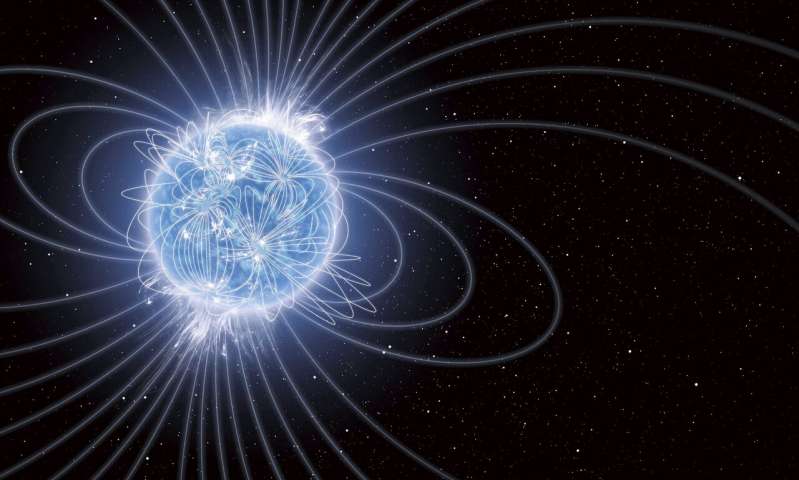Scientists spot possible 'missing link' between weird magnetars and pulsars

Researchers have apparently found a "missing link" between two types of pulsars.
Pulsars are fast-spinning neutron stars, the superdense, collapsed cores left over from the explosive deaths of massive stars. Pulsars emit beams of radiation from their poles that appear to pulse when they're observed from Earth, hence the name. (Pulsars don't actually pulse, though; that's an effect of the objects' rotation.)
Scientists had thought that two kinds of pulsars — magnetars, which sport extremely powerful magnetic fields, and rotation-powered pulsars — emit their beams in different ways. But a new study suggests that these extreme objects have more in common than was previously presumed.
"Our study has given us new understanding of the neutron stars with high magnetic fields," study leader Chin-Ping Hu, a visiting researcher at the RIKEN Cluster for Pioneering Research in Japan, said in a statement.
Related: Neutron-star crash: A gravitational wave discovery in pictures
On March 12, scientists discovered a new gamma-ray burst with the Burst Alert Telescope aboard NASA's Neil Gehrels Swift Observatory, a space-based gamma ray telescope. The object, J1818.0-1607, which the researchers believe is a magnetar, immediately inspired followup X-ray observations with the Neutron star Interior Composition Explorer (NICER), an instrument aboard the International Space Station.
Using NICER, the researchers found that the magnetar has a pulsation period — the time between stellar pulsations — of 1.36 seconds, the shortest ever spotted in a magnetar. They also found that the magnetar is fairly young, forming just 420 years ago (from our perspective, anyway; the object lies 16,000 light-years from Earth, so everything astronomers are observing with the magnetar happened long ago). Strangely, they also found that this magnetar's X-ray emission was lower than that of other magnetars.
Get the Space.com Newsletter
Breaking space news, the latest updates on rocket launches, skywatching events and more!
Notably, the team saw that the magnetar was exhibiting "spin-down behavior." Because of this, they think that its emissions were, at least in part, powered by rotation. This is significant because, typically, rotation-powered pulsars are thought to be the ones that produce beams through rotating. So this finding draws the two objects closer together and expands scientists' understanding of how and why these objects produce their beams, team members said.
Additionally, Hu added, "recent radio observations suggest that magnetars may be a cause of mysterious phenomena called fast radio bursts, so we look forward to investigating further."
This work was published Oct. 7 in the Astrophysical Journal.
Email Chelsea Gohd at cgohd@space.com or follow her on Twitter @chelsea_gohd. Follow us on Twitter @Spacedotcom and on Facebook.
Join our Space Forums to keep talking space on the latest missions, night sky and more! And if you have a news tip, correction or comment, let us know at: community@space.com.

Chelsea “Foxanne” Gohd joined Space.com in 2018 and is now a Senior Writer, writing about everything from climate change to planetary science and human spaceflight in both articles and on-camera in videos. With a degree in Public Health and biological sciences, Chelsea has written and worked for institutions including the American Museum of Natural History, Scientific American, Discover Magazine Blog, Astronomy Magazine and Live Science. When not writing, editing or filming something space-y, Chelsea "Foxanne" Gohd is writing music and performing as Foxanne, even launching a song to space in 2021 with Inspiration4. You can follow her on Twitter @chelsea_gohd and @foxannemusic.
